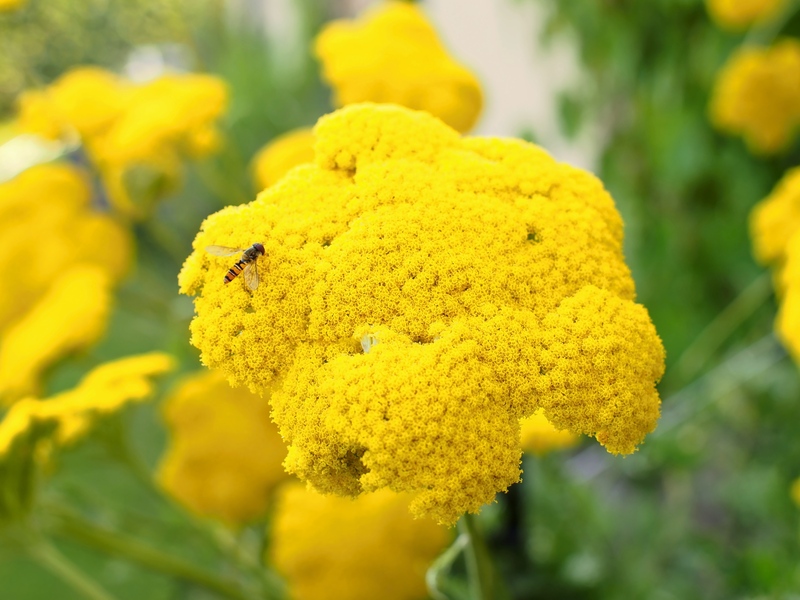Transform Your Space: Tips for Crafting a Thriving Herb Garden
Posted on 01/06/2025
Transform Your Space: Tips for Crafting a Thriving Herb Garden
Herb gardens are a wonderful addition to any home or apartment. Not only do they bring vibrant beauty and fresh fragrances to your space, but they also provide you with homegrown flavors that elevate your culinary creations. Whether you live in a small urban apartment or a spacious suburban home, cultivating a flourishing herb garden is entirely within your reach. In this comprehensive guide, we'll provide you with expert tips for designing, planting, and maintaining a thriving herb garden--indoors or outdoors.
Why Grow a Herb Garden?
Herbs are versatile, easy to grow, and deliver a host of benefits:
- Fresh ingredients for your kitchen year-round
- Natural beauty for windowsills, balconies, patios, and gardens
- Aromatic scents that uplift your indoor spaces
- Eco-friendly living by reducing food waste and packaging
- Therapeutic activity with gardening's stress-reducing qualities
Imagine stepping out to your balcony or kitchen countertop for a snip of fresh basil, mint, or rosemary whenever you need it. With the right strategies, you can craft a lush herb oasis in virtually any space.

Planning Your Herb Garden: Indoor and Outdoor Options
Every thriving herb garden starts with smart planning. Let's look at some options and considerations for transforming your space with homegrown herbs, whether indoors or out.
Choosing the Right Location
- Sunlight: Most herbs require 6-8 hours of sunlight per day. Select a spot with direct sun--think windowsills, balconies, patios, or under grow lights indoors.
- Accessibility: Position your herb garden where you can water, trim, and harvest regularly. Kitchens, porches, or high-traffic paths work well.
- Protection: Outdoors, choose a sheltered area that's shielded from strong winds and extreme weather. Indoors, avoid drafty windows and excessive heat near radiators.
Containers or Garden Beds?
Herbs are highly adaptable. Here's how to set up your herb garden based on your space:
- Container Herb Garden: Perfect for apartments or balconies. Use pots, window boxes, vertical planters, or even recycled containers.
- Raised Beds: Great for larger yards. Easier to manage and keep soils fertile.
- In-Ground Gardens: Traditional gardening option, ideal for those with ample space and sun.
Tip: For beginners, start small. A few well-chosen containers on a sunny ledge or a compact raised bed is less overwhelming and easy to maintain.
How to Select the Best Herbs for Your Space
Your herb selection should reflect your culinary tastes, available space, and growing conditions. Here are some top picks:
- Basil: Loves warmth and sunlight; perfect for Italian dishes.
- Mint: Fast-growing, refreshing flavor; thrives in slightly cooler spots. Container recommended (spreads aggressively).
- Rosemary: Aromatic shrub; prefers well-draining soil and full sun.
- Parsley: Versatile biennial; tolerates partial shade.
- Thyme: Compact, drought-resistant; ideal for small gardens.
- Cilantro: Cool-weather annual; grows quickly from seed.
- Chive: Mild onion flavor; hardy and low-maintenance.
- Sage: Perennial with earthy taste; great for seasoning roasts and stews.
Experiment with various herb varieties that suit both your palate and your space's light conditions. Don't hesitate to mix culinary herbs with medicinal or aromatic varieties such as lavender or lemon balm.
Essential Elements for a Flourishing Herb Garden
To ensure your herb garden thrives year-round, focus on these fundamental needs:
Soil Selection and Preparation
- Quality counts: Use a light, well-draining potting mix for containers. For garden beds, enrich soil with compost.
- Herb-specific needs: Some herbs, like rosemary and thyme, prefer sandy soil, while basil flourishes in rich organic matter.
- pH balance: Aim for a neutral pH (6-7) for most herbs.
Watering Wisely
- Regular but moderate: Overwatering is the biggest threat to most herbs. Let the soil surface dry before watering again.
- Drainage is critical: Ensure containers have drainage holes. Use trays to catch excess water indoors.
- Mulch: Applying organic mulch helps retain moisture and regulate temperature in outdoor beds.
Lighting Requirements
- Maximize natural light: South- or west-facing windows provide the best exposure for indoor herb gardens.
- LED grow lights: Essential for spaces with low sunlight--opt for full-spectrum bulbs to mimic daylight.
- Rotate plants: Turn your containers every few days so all sides get equal sun for even growth.
Temperature and Humidity
- Ideal range: Most herbs prefer daytime temps between 65-75?F (18-24?C).
- Avoid extremes: Drafts, heat vents, and frigid windows can stunt growth; adjust herb placement as needed.
- Humidity boost: Occasionally mist herbs or group pots together to improve humidity indoors.
Designing Your Unique Herb Garden Space
Transforming your home or garden with herbs isn't just functional--it's also about creating beauty and enjoyment in your daily life. Here are some design ideas to inspire you:
Vertical Herb Gardens
- Wall-mounted planters: Perfect for tight spaces; create living green art in your kitchen or patio.
- Pallet gardens: Upcycle old pallets into rustic vertical gardens.
- Trellises and shelving: Hang pots on ladders or tiered shelves to make the most of vertical space.
Herb Garden on the Windowsill
- Compact planters: Choose pots or boxes that fit snugly on your sunniest sill.
- Mix and match: Combine small-leaved herbs (like thyme and chives) for variety.
- Label your herbs: Add stylish markers to help identify each plant and add a decorative touch.
Outdoor Raised Beds and Container Arrangements
- Themed herb beds: Grow Italian, French, or tea herbs together for easy access when cooking or making drinks.
- Companion planting: Benefit from natural pest-repellent combinations. For example, pair basil with tomatoes, or rosemary with beans.
- Pathway borders: Line garden paths with fragrant herbs like lavender or oregano for a sensory experience.
Creative Indoor Herb Garden Displays
- Hanging baskets: Suspend herbs from the ceiling or under cabinets to free up counter space.
- Repurposed containers: Use mugs, teacups, or recycled tins for quirky charm.
- Hydroponic systems: Automated indoor gardens are perfect for beginners and tech enthusiasts.
Planting and Caring for Your Herb Garden
Ready to bring your herb garden to life? Here's how to plant and maintain your herbs for year-round success:
Starting Plants from Seeds vs. Seedlings
- Seeds: More affordable and offer greater variety. Start indoors 4-8 weeks before the last frost or sow directly outdoors in spring.
- Seedlings: Convenient and provide faster results--ideal for beginners or those eager to harvest quickly.
Quick tip: Moisten the soil before seeding or transplanting, and avoid overcrowding, as herbs need space to grow freely.
Essential Herb Garden Maintenance
- Regular harvesting: Snip leaves frequently to encourage bushier growth and prevent flowering (bolting), which can alter flavor.
- Pruning: Pinch off the tips of woody herbs (like basil and mint) to keep plants compact.
- Fertilize sparingly: Over-fertilizing can reduce flavor intensity. Use organic or compost-based feeds a few times a season.
- Pest and disease checks: Keep an eye out for aphids or mildew. Combat naturally with neem oil, insecticidal soaps, or by encouraging beneficial insects.
Herb Garden Troubleshooting
- Yellow leaves: Could be a sign of overwatering--let soil dry before the next watering.
- Limp growth: Indicates not enough direct sunlight; move plants or add a grow light.
- Leggy herbs: Stems are stretching for light. Rotate or move to a sunnier location.
- Bolting (flowering): Snip off flower buds as soon as you see them to extend the harvest window.
Harvesting, Preserving, and Using Your Homegrown Herbs
One of the biggest joys of crafting a thriving herb garden is the ability to pick fresh herbs whenever you need them. Here's how to harvest and store your bounty:
- Harvest in the morning: Essential oils are strongest just after the dew dries, for peak fragrance and flavor.
- Use sharp scissors: Cut just above a leaf node (where leaves join the stem) to encourage new growth.
- Preserve surplus herbs: Dry, freeze, or infuse them in oils to enjoy throughout the year. Air drying works well for rosemary, sage, and thyme. Tender herbs like basil and parsley do better frozen or in pesto.
Creative Uses for Fresh Herbs
- Culinary delights: Experiment with new recipes--from herbed butters to fragrant teas and vibrant sauces.
- Aromatherapy: Place pots near entryways or bathrooms for natural air freshening.
- Herbal remedies: Steep mint, chamomile, or lemon balm for soothing teas and wellness blends.
- Crafts and gifts: Bundle and dry herbs for homemade wreaths, sachets, or thoughtful gifts.

Frequently Asked Questions: Thriving Herb Gardens
What are the best herbs for beginner gardeners?
Some of the most forgiving and quick-growing herbs for beginners include basil, mint, chives, and parsley. They adapt well to containers, require modest care, and reward you with frequent harvests.
Can I grow a herb garden in the shade?
While most herbs crave full sunlight, there are shade-tolerant varieties such as mint, parsley, and cilantro. Place these in areas with filtered sunlight or partial shade for best results.
How long do herbs take to grow?
From seed, most herbs are ready to harvest in 4-8 weeks. Some perennials, like rosemary and sage, take longer to mature but will reward you for years with consistent care.
Final Thoughts: Transform Your Space with a Lush Herb Garden
A thriving herb garden transforms more than just your home--it enriches your daily life, encourages sustainable living, and provides you with endless inspiration in the kitchen. By choosing the right plants, containers, and care methods, you can enjoy a lush oasis no matter the size or location of your space.
Take your time with the process and don't be afraid to experiment. Each harvest brings new flavors and possibilities. Start planting today and watch as your windowsill, patio, or backyard flourishes into a personalized, aromatic retreat that nurtures both body and soul.
Remember: No matter your space, a beautiful, productive herb garden is well within your reach. Happy planting!



